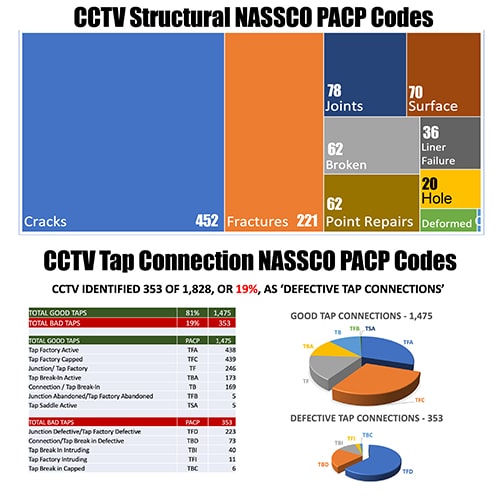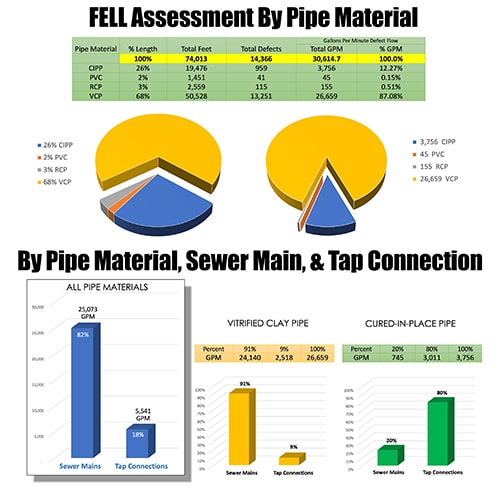
Key Findings and the Executive Summary are presented for a first-of-its-kind 14-mile North American pipeline benchmark study, comparing Closed-Circuit Television (CCTV) inspection against Focused Electrode Leak Location (FELL) inspection results. Both inspection techniques were completed by the same national pipeline contractor.
FELL inspection was completed in accordance with ASTM F2550, Standard Practice for Locating Leaks in Sewer Pipes By Measuring the Variation of Electric Current Flow Through the Pipe Wall. CCTV inspection was completed using National Association of Sewer Service Companies (NASSCO) Pipe Assessment Certification Program (PACP) codes.
The project was conducted between August 2019 and March 2020, which assessed 322 gravity sewer mains, totaling 74,000 linear feet (LF), and included over 1,800 customer tap connections to the sewer mains. Pipe diameters ranged from 8 to 12 inches for nearly 90% of the study area, while the remaining sewer main sizes varied up to 27 inches in diameter.
The benchmarks primary purpose was to directly compare CCTV and FELL inspection results with respect to documenting infiltration sources in sewers mains for a Utility operating under an Environmental Protection Agency Consent Decree.
Please note, this benchmark is the first major evaluation of its kind to identify infiltration sources by comparing more conventional CCTV inspection results to innovative FELL inspection. Study results using FELL data quantified leakage in both sewer mains and at customer tap connections, which are defined as the location where a customer’s sewer lateral connects to the sewer main.
FELL inspection quantified potential infiltration flow rates in Gallons per Minute (GPM) for all sewer mains defects as well as at each defective tap connection. This is not true of CCTV inspection which, except for making estimates by operators from leaks only if visible at the time of inspection, cannot quantify infiltration flow rates.
Four (4) pipe material types were assessed, including: Vitrified Clay Pipe (68%), Cured-In-Place Pipe (26%), Reinforced Concrete Pipe (4%), and Polyvinyl Chloride (2%).
KEY FINDINGS
Findings from both CCTV and FELL inspection methods were dramatically different. While CCTV inspection used high-resolution cameras maneuvered by field operators, camera-based visual technologies are not able to determine whether cracks are superficial or go through a pipe wall and contributing to infiltration. Assessing joint conditions is also problematic. The inside of bells and spigot pipe configurations cannot be visually inspected for the deteriorating mortar or to determine if a water-tight seal remains.
As part of this study, a third-party data analytics firm used three (3) commercially available Artificial Intelligence (AI) and Machine Learning (ML) applications, able to assess the same CCTV videos on a frame-by-frame basis. Whether manual PACP coding was applied, or AI algorithm processing, the visual inspection was unable to accurately determine joint conditions, leaks at cracks, and defective tap locations to quantify infiltration sources when a wet-weather event occurs.

CCTV Inspection Findings:
- Only 78 joint defects were identified in the 54,500 LF of VCP.
- Operators recorded only 19% defective tap connections of all connections identified.
- Assuming 4 ft average joint lengths, CCTV ranked over 99% of all VCP pipe joints as ‘leak-free.’
- Thirteen (13) different CCTV operators recorded inconsistent, often inaccurate results, and many times list NO PACP CODES for defects.
- A total of 21 CCTV surveys were abandoned, and none showed reverse set-ups to evaluate defect locations.
- Only 39 total PACP infiltration observations were noted, and only 6 pipes documented one or more infiltration observations.
- There were 36 CIPP liner failures identified, with 32 PACP observations restricted to just 5 pipes.
- Only 89 of 265, or 34%, of all PACP codes were used to identify defects or general observations.
Unlike CCTV, FELL technology precisely located pipe leak locations to within 3/8 inches (1 cm), and critically quantified each leak in GPM. Coupled with FELL-based AI software to locate specific pipe features, FELL technology was able to match leak locations to pipe walls, joints, or tap connections.
FELL Inspection Findings:
- Over 14,000 total individual pipe defects contributing to infiltration were documented, with an estimated 30,000 GPM of potential infiltration.
- For the VCP, over 13,000 pipe defects were identified, contributing to 87% of potential infiltration in the entire study area.
- For the CIPP, over 950 pipe defects were identified, contributing to 12% of potential infiltration.
- A total of over 1,500 defective customer taps were identified, or 83% of the total, with defects contributing to infiltration.
- For the VCP, over 90% of the potential infiltration was attributed to Sewer Mains, and only 9% attributed to defective tap connections.
- For the CIPP, only 20% of the potential infiltration was attributed to Sewer Mains (i.e., liner defects), and 80% attributed to defective tap connections.
- Comparing FELL defects to CCTV videos, after FELL data was processed, FELL identify 100% of defective tap connections.

TAP CONNECTIONS
This benchmark represents the most comprehensive analysis to date, evaluating CCTV operator performance to correctly assess & report defective tap connections. As noted above, while CCTV recorded nearly 80% of all tap connections as ‘GOOD’ (i.e., no infiltration potential), by dramatic contrast FELL tests recorded 80% of all tap connections as ‘DEFECTIVE’ (i.e., contributing to potential infiltration). The limited defect observations made by CCTV inspection for sewer mains, coupled with the under-statement of defective tap connections, is the key factor in over-stating leakage rates in sewer laterals. Study results clearly show visual inspection limitations to accurately locate, quantify, and differentiate leaks between sewer mains and tap connections. The result contributes to ongoing over-estimation of infiltration associated with lateral pipes, (i.e., the customer sewer pipes connecting homes & businesses to sewer mains).
CURED-IN-PLACE PIPE
Results from CCTV reports of the CIPP liners were significantly different than results from FELL leak detection. Study results directly contradicted long-standing claims by CIPP suppliers and contractors, CCTV manufacturers and operators, and NASSCO that has assert visual CCTV inspection is the best way to certify CIPP liners as watertight. The benchmark results conclude the opposite. Specifically, CCTV inspections only identified 36 Liner Failure observations, limited to Abandoned Connections (21), Blistered Linings (4), Delaminating (1), Wrinkles (9), and Other (1). Nevertheless, the CIPP liners in this study only represented 26% of total project length yet was responsible for 3,700 GPM in potential infiltration flow. While CCTV generally stated both sewer main linings and tap reinstatements as ‘GOOD,’ FELL technology precisely located and quantified leak locations in CIPP liners and tap connections with excessive leakage.
EARLIER CCTV-FELL COMPARISON
Prior to this landmark study, the largest CCTV – FELL comparison was completed by the Ras Al Khaima Wastewater Authority (RAKWA), in the United Arab Emirates (UAE). Results from that study were presented at the 2019 Annual International Society of Trenchless Technology Conference in Florence, Italy. A total of 211 sewer pipes were inspected, representing over 15-kilometers (9.3-miles). The same contractor was responsible for both CCTV and FELL inspections. Based on FELL results, RAKWA prioritized a rehabilitation program, including testing & certification of UV-cured CIPP to eliminate 100% of tidal infiltration. These results have been confirmed by ongoing pump station monitoring. There were no tap connections in the study area, as this was relatively new PVC pipe and many laterals are typically connected at manholes and not at intermediate pipe locations between manholes.
Details of this CCTV-FELL North American benchmark study may be requested by contacting Electro Scan Inc.

